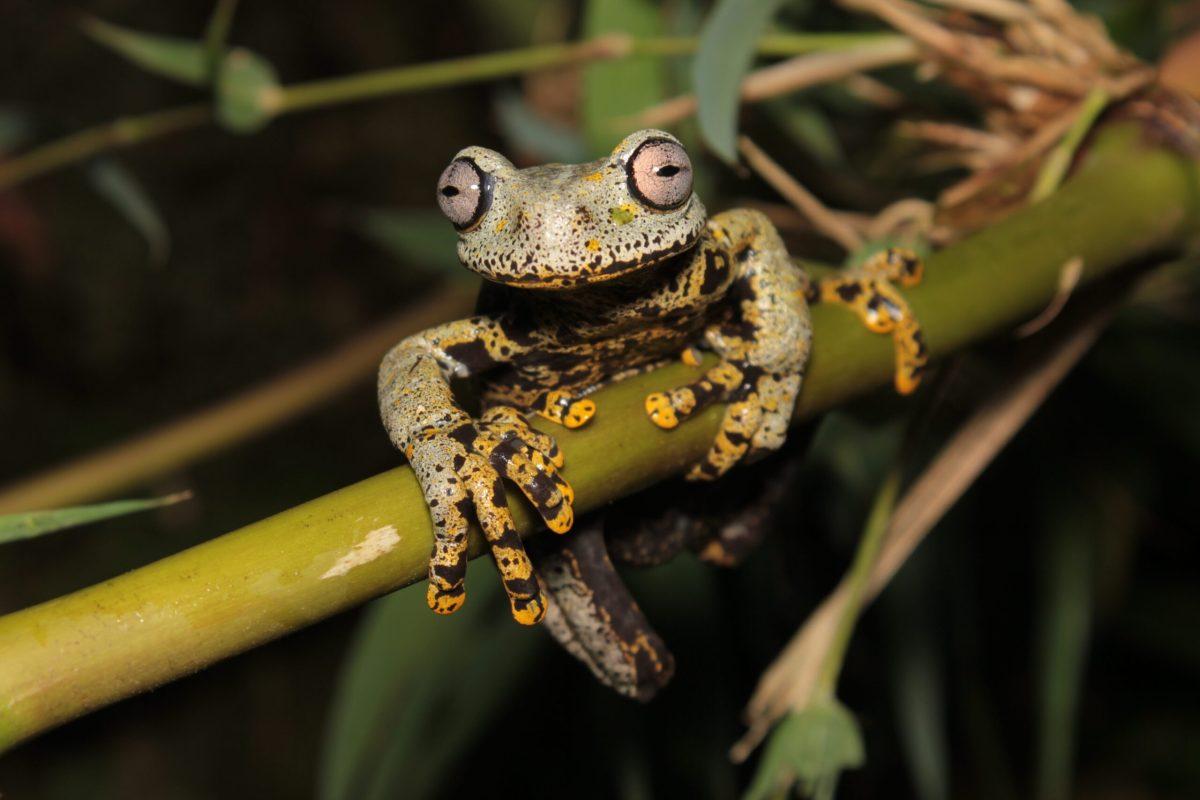How many species go extinct each day?
This is impossible to answer precisely. New species appear all the time and can go extinct before they’ve even been described and estimates as to the rates of extinction very enormously. One approach to working it out would be to first take the yearly ‘natural extinction rate’ – the rate at which species would go extinct if we humans weren’t around. This is often stated as one per million (or 0.00001%) per year – but again, opinion on this varies.
Experts now believe that current rates of extinction have soared to between 1,000 and 10,000 times this natural rate. So, take the natural rate as one per million and that brings current rates to between 0.01 and 0.1% per year. There are said to be 1.6 million described species on our planet, but some experts believe there could be as many as 100 million. So, work out the worse- case scenario math’s and the daily rate of extinction comes in at 273 species per day.

Stream treefrog (Hyloscirtus tolkieni), Ecuador

Just a single individual of Hyloscirtus tolkieni, a stream treefrog, has been found and captured, despite focused searches during the initial fieldwork. However, this one individual was enough for the authors of this paper to be able to describe it as a new species. This is because it was distinct enough in its morphology from other species in the Hyloscirtus genus.
With only one individual found so far, the species’ known distribution is limited to the place where it was found and captured – the southern eastern slopes of the Cordillera Oriental, a chain of Andean mountains in the Río Negro-Sopladora National Park of Ecuador.
Bent-toed gecko (Cyrtodactylus santana), Democratic Republic of Timor-Leste

The world’s fourth youngest country Democratic Republic of Timor-Leste, occupying the eastern half of the island of Timor which is part of the Lesser Sunda Islands, has had its first species of bent-toed gecko described by scientists.
The gecko was first found during the day in the Lene Hara cave in Nino Koni’s Santana National Park, and initially evaded efforts by the scientists to catch it. Returning at night, as bent-toed geckos are nocturnal and would be less skittish then, the scientists were able to catch ten of the geckos. Genetic and morphological analysis confirmed that it was an undescribed species.
The expedition which caught the geckos also found a number of plants and crabs that are being analysed and may prove to also be undescribed species.
The specific epithet ‘Santana’ is derived from the Nino Konis Santana National Park where it was found, and which is named in honor of the freedom fighter Nino Konis Santana who was born within the boundaries of the park.
Gymnures (Podogymnura intermedia and P. minima), Philippines

With its golden-brown fur and pointed nose, P. intermedia looks a lot like a shrew, but belongs to a group of mammals known as gymnures. They are also known as hairy hedgehogs or moonrats and are closely related to hedgehog.
Like all other members of the Podogymnura genus, P. intermedia is found in the Philippines. It was found during a survey on the mountains of eastern Mindanao, where there had never been surveys for mammals before.
“One of the highly distinct things about the Philippines is that every isolated mountain or little mountain range where we have done surveys is that each and every one has several species that occur nowhere else not even on adjacent mountain ranges on the same island,” says co-author Laurence Henery, Negaunee Curator of Mammals at the Field Museum in Chicago. “If you don’t go look, you don’t know what is there.”
The specific epithet ‘intermedia’ is derived from the Latin word ‘intermedium’, translating to ‘intermediate’. It was used for this new hedgehog-like as the species is intermediate in size between P. auroespinula (the largest member of the genus) and the other two species, P. truei and P. minima.
It is also intermediate in the amount of golden colour in its fur. “P. truei and P. minima have dark fur with tiny golden sparkles, P. intermedia has golden streaks in the fur, and P. aurospinula has long golden hairs mixed into its pelage,” says Heaney. “They are all pretty cute animals.”
It’s hoped that further surveys can be undertaken to learn more about the species, but with preparations for undertaking them, doing the fieldwork in remote areas and then analysing the data all being very time-consuming, it’s unknown when these will be able to take place.
Although indigenous people and conservation groups are hoping to preserve their homelands, the species may be threatened by habitat destruction and degradation if mining and agriculture expand in the area, as well as building roads to increase access.














































